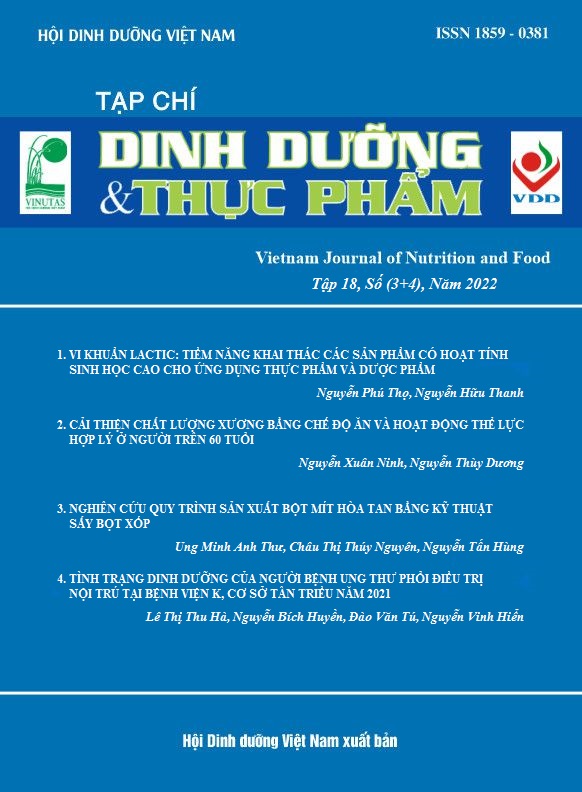STUDY ON PRODUCTION OF FRUIT POWDER FROM THAILAND JACKFRUIT (Artocarpus heterophyllus Lam.) BY FOAM MAT DRYING
Main Article Content
Abstract
Aims: To determine the appropriate parameters for the production process of jackfruit powder from “Changai” small size jackfruit by foam mat drying technique.
Methods: The study was carried out on the basis of investigating the factors (i) affecting the foaming process (egg albumin and carboxylmethyl cellulose concentrations) and (ii) the influence of hot air drying conditions (drying temperature and foam thickness) onthe quality of jackfruit powder.
Results: Tackfruit juice was stirred with egg albumin (4%) and CMC (7.5%) to help create a good and sustainable foam film. On the other hand, the foam layer was dried at 60oC and 3mm thick to help recover the powder with good color and best kept nutrient content with vitamin C content of 3.96 mg%; carotenoid content of 5.34 μg/g; total sugar of 11.27%, reducing sugar content of 8.33 g/100g and the total acid content of 0.077% and moisture of 4.28%.
Conclusion: This research result helps to diversify products from jackfruit by a new drying method to reduce input costs but still ensure quality.
Keywords
Albumin, CMC, carotenoid, fackfruit, foam mat, vitamin C
Article Details
References
2. An, V. N., Thinh, P. Van, Do, V. L., Duy, N. Q., Thuy, D. T., & Hien, T. T. (2022). The Influencing Factors on the Production of Alcoholic Drinking from Jackfruit (Artocarpus heterophyllus L.). Materials Science Forum, 1048 MSF(October), 476–484.
3. Kumoro, A. C., Sari, D. R., Pinandita, A. P. P., Retnowati, D. S., & Budiyati, C. S. (2012). Preparation of wine from jackfruit (Artocarpus heterophyllus lam) Juice using baker yeast: Effect of yeast and initial sugar concentrations. World Applied Sciences Journal, 16(9), 1262–1268.
4. Marak, N. R., Nganthoibi, R. K., & Momin, C. W. (2019). Process Development for Brining of Tender Jackfruit. International Journal of Current Microbiology and Applied Sciences, 8(04), 2408–2414.
5. Phisut, N. (2012). Spray drying technique of fruit juice powder:some factors influencing the properties of product. International Food Research Journal, 19(4), 1297–1306.
6. G. Pandidurai and P. Vennila. (2018). Studies on Development of Fruit Powder from Muskmelon ( Cucumis Melo L .) by Using Spray Drier. Madras Agric. J., 105 (4-6): 215-219.
7. Salahi, M. R., Mohebbi, M., & Taghizadeh, M. (2017). Development of cantaloupe (Cucumis melo) pulp powder using foam-mat drying method: Effects of drying conditions on microstructural of mat and physicochemical properties of powder. Drying Technology, 35(15), 1897–1908.
8. Wang, Y., T. D. Wig, J. Tang, and L. M. Hallberg. 2003. Dielectric properties of foods relevant to RF and microwave pasteurization and sterilization. Journal of Food Engineering, 57:257–268.
9. Quek, S. Y., Chok, N. K., & Swedlund, P. (2007). The physicochemical properties of spray-dried watermelon powders. Chemical Engineering and Processing: Process Intensification, 46(5), 386–392.
10. Khamjae, T., & Rojanakorn, T. (2018). Foam-mat drying of passion fruit aril. International Food Research Journal, 25(1), 204–212.
11. Macedo, L. L., Corrêa, J. L. G., Araújo, C. da S., Vimercati, W. C., & Pio, L. A. S. (2021). Process optimization and ethanol use for obtaining white and red dragon fruit powder by foam mat drying. Journal of Food Science, 86(2), 426–433.
12. Azizpour, M., Mohebbi, M., & Khodaparast, M. H. H. (2016). Effects of foam-mat drying temperature on physico-chemical and microstructural properties of shrimp powder. Innovative Food Science and Emerging Technologies, 34, 122–126.
13. Franco, T. S., Perussello, C. A., Ellendersen, L. N., & Masson, M. L. (2016). Effects of foam mat drying on physicochemical and microstructural properties of yacon juice powder. LWT - Food Science and Technology, 66, 503–513.
14. Ozkan, I. A., Akbudak, B., & Akbudak, N. (2007). Microwave drying characteristics of spinach. Journal of Food Engineering, 78(2), 577–583.
15. Zheng, X.-Z., Liu, C.-H., & Zhou, H. (2011). Optimization of Parameters for Microwave-Assisted Foam Mat Drying of Blackcurrant Pulp. Drying Technology, 29(2), 230–238.
16. Kadam, D. M., Wilson, R. A., Kaur, S., & Manisha. (2012). Influence of foam mat drying on quality of tomato powder. International Journal of Food Properties, 15(1), 211–220.
17. Rajkumar, P., Kailappan, R., Viswanathan, R., Raghavan, G. S. V., & Ratti, C. (2007). Foam mat drying of Alphonso mango pulp. Drying Technology, 25(2), 357–365.
18. Muratore, G., Rizzo, V., Licciardello, F., and Maccarone, E. (2008). Partial dehydration of cherry tomato at different temperatures and nutritional quality of the products. Food Chemistry 111: 887-891.
Similar Articles
- Hà Thùy Linh, Nguyễn Mạnh Đạt, Nguyễn Thị Minh Tú, NGHIÊN CỨU ỨNG DỤNG ĐƯỜNG TREHALOSE TRONG LÊN MEN SỮA CHUA , Vietnam Journal of Nutrition & Food: Vol. 16 No. 2 (2020)
You may also start an advanced similarity search for this article.


